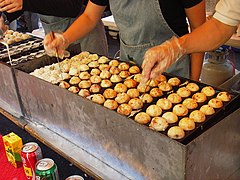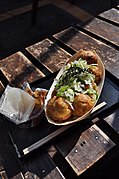Takoyaki
 A "boat" of takoyaki | |
| Course | Snack |
|---|---|
| Place of origin | Japan |
| Region or state | Osaka |
| Main ingredients | Batter, octopus, tempura scraps (tenkasu), pickled ginger, green onion, takoyaki sauce (with mayonnaise), green laver (aonori) |
| Variations | Taiwanese cuisine |
Takoyaki (たこ焼き or 蛸焼) or "octopus balls" is a ball-shaped Japanese snack made of a wheat flour-based batter and cooked in a special molded pan. It is typically filled with minced or diced octopus (tako), tempura scraps (tenkasu), pickled ginger (beni shoga), and green onion (negi).[1][2] The balls are brushed with takoyaki sauce (similar to Worcestershire sauce) and mayonnaise, and then sprinkled with green laver (aonori) and shavings of dried bonito (katsuobushi).
Yaki comes from yaku (焼く), which is one of the cooking methods in Japanese cuisine, meaning 'to fry or grill', and can be found in the names of other dishes in Japanese cuisine such as okonomiyaki and ikayaki (other famous Osakan dishes).[3]
History[]
Takoyaki was first popularized in Osaka,[4] where a street vendor named Tomekichi Endo is credited with its invention in 1935. Takoyaki was inspired by akashiyaki, a small round dumpling from the city of Akashi in Hyōgo Prefecture made of an egg-rich batter and octopus.[5] Takoyaki was initially popular in the Kansai region, and later spread to the Kantō region and other areas of Japan. Takoyaki is associated with yatai street food stalls, and there are many well-established takoyaki specialty restaurants, particularly in the Kansai region. Takoyaki is now sold at commercial outlets, such as supermarkets and 24-hour convenience stores.[6]
It is also very popular in Taiwanese cuisine due to the historical influence of Japanese culture.[7]
The oldest known takoyaki store is Aizuya in Osaka. Founded by Tomakichi Endo, it has been open since the 1930s. The first takoyaki included beef and konjac, but later Endo switched to using the now traditional octopus and added flavor to the batter. The takoyaki are then eaten with brown sauce, similar to Worcestershire sauce. The food, known as "octopus balls", quickly became popular throughout Japan.[8][9]
Takoyaki pan[]
A takoyaki pan (たこ焼き器, takoyaki-ki) or—much more rarely—takoyaki-nabe (たこ焼き鍋) is typically a griddle made of cast iron with hemispherical molds.[2] The heavy iron evenly heats the takoyaki, which are turned with a pick during the heating process to pull the uncooked batter to the base of the rounded cavity. Commercial gas-fueled takoyaki cookers are used at Japanese festivals or by street vendors. For home use, electric versions resemble a hotplate; stovetop versions are also available.
In popular culture[]
A children's book named Takoyaki Mantoman published in the 1990s and later adapted into an anime television series produced by Studio Pierrot that aired from April 1998 to September 1999. Takoyaki was featured on the Netflix Television series, Street Food, in the Osaka, Japan episode.[10]
Image gallery[]

Cooking takoyaki

Takoyaki served with Japanese "Worcester" sauce and mayonnaise

Takoyaki served with grated daikon and tsuyu

A takoyaki yatai in Yoyogi Park, Tokyo

Square takoyaki pan with 16 molds

Open kitchen store
See also[]
- Similar global dishes
- Æbleskiver in Denmark
- Cekodok in Malaysia
- Poffertjes in Netherlands
- Kue cucur in Indonesia
- Unniyappam and neyyappam (both sweet dishes) and paddu (plain or spicy but vegan) in south India
References[]
- ^ "蛸焼" [Takoyaki]. Dijitaru daijisen (in Japanese). Tokyo: Shogakukan. 2012. OCLC 56431036. Archived from the original on 2007-08-25. Retrieved 2012-06-22.
- ^ Jump up to: a b "Takoyaki". Encyclopedia of Japan. Tokyo: Shogakukan. 2012. OCLC 56431036. Archived from the original on 2007-08-25. Retrieved 2012-06-22.
- ^ Takiyaki, the great street snack
- ^ "蛸焼" [Takoyaki]. Nihon Kokugo Daijiten (in Japanese). Tokyo: Shogakukan. 2012. OCLC 56431036. Archived from the original on 2007-08-25. Retrieved 2012-06-17.
- ^ Takoyaki - Icon of Osaka
- ^ "Takoyaki | food | Culture | Japan Dream Tours". japandreamtours.com. Retrieved 2019-10-16.
- ^ "In Taiwan, top chefs are building on a long history of culinary exchange with Japan", The Japan Times. Retrieved 2018-02-28.
- ^ "【飲食籽】快閃大阪 嘆米芝蓮章魚燒". Apple Daily 蘋果日報. Retrieved 2019-03-07.
- ^ "可愛章魚小丸子". 太陽報 (in Chinese). Retrieved 2019-03-07.
- ^ Hallinan, Bridget. "'Street Food' Season One: All of the Chefs Featured, and Where to Find Them". Food & Wine. Meredith Corporation. Retrieved 3 May 2021.
External links[]
| Wikimedia Commons has media related to Takoyaki. |
- Making Classic Takoyaki at Home A DIY Takoyaki recipe.
- Street food
- Octopus dishes
- Japanese cuisine
- Japanese food preparation utensils






